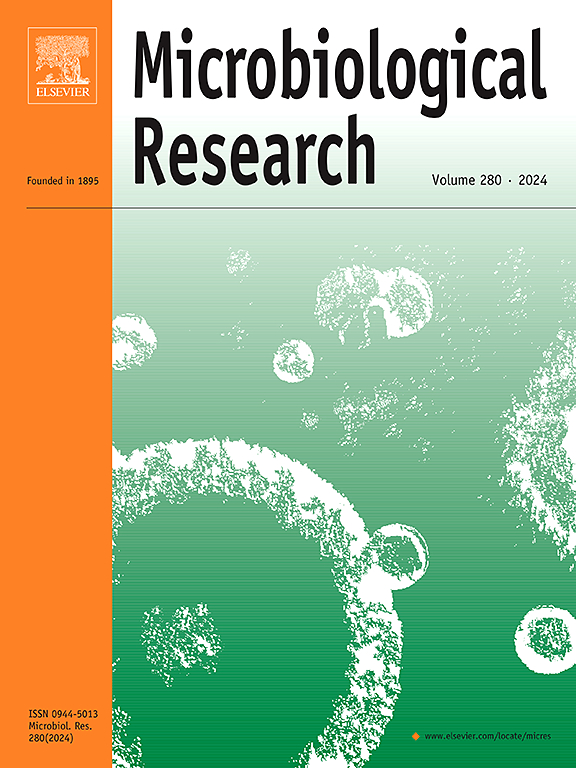Sterol regulatory element-binding proteins mediate intrinsic fungicide tolerance and antagonism in the fungal biocontrol agent Clonostachys rosea IK726
IF 6.1
1区 生物学
Q1 MICROBIOLOGY
引用次数: 0
Abstract
Sterol regulatory element-binding proteins (SREBPs) are transcription factors governing various biological processes in fungi, including virulence and fungicide tolerance, by regulating ergosterol biosynthesis and homeostasis. While studied in model fungal species, their role in fungal species used for biocontrol remains elusive. This study delves into the biological and regulatory function of SREBPs in the fungal biocontrol agent (BCA) Clonostachys rosea IK726, with a specific focus on fungicide tolerance and antagonism. Clonostachys rosea genome contains two SREBP coding genes (sre1 and sre2) with distinct characteristics. Deletion of sre1 resulted in mutant strains with pleiotropic phenotypes, including reduced C. rosea growth on medium supplemented with prothioconazole and boscalid fungicides, hypoxia mimicking agent CoCl2 and cell wall stressor SDS, and altered antagonistic abilities against Botrytis cinerea and Rhizoctonia solani. However, Δsre2 strains showed no significant effect. Consistent with the gene deletion results, overexpression of sre1 in Saccharomyces cerevisiae enhanced tolerance to prothioconazole. The functional differentiation between SRE1 and SRE2 was elucidated by the yeast-two-hybridization assay, which showed an interaction between SREBP cleavage-activating protein (SCAP) and SRE1 but not between SRE2 and SCAP. Transcriptome analysis of the Δsre1 strain unveiled SRE1-mediated expression regulation of genes involved in lipid metabolism, respiration, and xenobiotic tolerance. Notably, genes coding for antimicrobial compounds chitinases and polyketide synthases were downregulated, aligning with the altered antagonism phenotype. This study uncovers the role of SREBPs in fungal BCAs, providing insights for C. rosea IK726 application into integrated pest management strategies.
甾醇调节元件结合蛋白介导真菌生物控制剂 Clonostachys rosea IK726 对杀真菌剂的内在耐受性和拮抗性。
甾醇调节元件结合蛋白(SREBPs)是一种转录因子,通过调节麦角甾醇的生物合成和平衡,控制真菌的各种生物过程,包括毒力和杀真菌剂耐受性。虽然对模型真菌物种进行了研究,但它们在用于生物防治的真菌物种中的作用仍然难以捉摸。本研究深入研究了 SREBPs 在真菌生物控制剂(BCA)Clonostachys rosea IK726 中的生物学和调控功能,特别关注杀真菌剂的耐受性和拮抗性。Clonostachys rosea 基因组包含两个 SREBP 编码基因(sre1 和 sre2),它们具有不同的特征。缺失 sre1 会导致突变株具有多生物表型,包括在添加了丙硫菌唑和溴螨脲杀菌剂、缺氧模拟剂 CoCl2 和细胞壁应激剂 SDS 的培养基上生长能力降低,以及对灰霉病菌和根瘤菌的拮抗能力改变。然而,Δsre2 菌株没有明显的影响。与基因缺失结果一致的是,sre1 在酿酒酵母中的过表达增强了对丙硫菌唑的耐受性。酵母双杂交试验阐明了 SRE1 和 SRE2 之间的功能差异,结果表明 SREBP 裂解激活蛋白(SCAP)与 SRE1 之间存在相互作用,而 SRE2 与 SCAP 之间没有相互作用。对 Δsre1 菌株的转录组分析揭示了 SRE1 介导的脂质代谢、呼吸和异生物耐受基因的表达调控。值得注意的是,编码抗微生物化合物几丁质酶和多酮合成酶的基因被下调,这与拮抗表型的改变相一致。这项研究揭示了 SREBPs 在真菌 BCA 中的作用,为 C. rosea IK726 应用于害虫综合治理战略提供了启示。
本文章由计算机程序翻译,如有差异,请以英文原文为准。
求助全文
约1分钟内获得全文
求助全文
来源期刊

Microbiological research
生物-微生物学
CiteScore
10.90
自引率
6.00%
发文量
249
审稿时长
29 days
期刊介绍:
Microbiological Research is devoted to publishing reports on prokaryotic and eukaryotic microorganisms such as yeasts, fungi, bacteria, archaea, and protozoa. Research on interactions between pathogenic microorganisms and their environment or hosts are also covered.
 求助内容:
求助内容: 应助结果提醒方式:
应助结果提醒方式:


